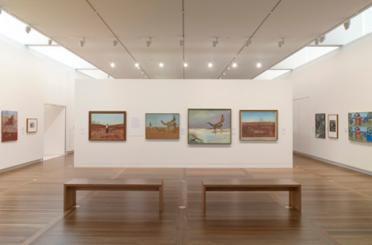Grey box is a highly durable Australian hardwood often used for heavy construction applications and flooring.
Gum-topped Box, Eucalyptus Microcarpa, Eucalyptus Woollsiana, Eucalyptus Hemiphloia
Eucalyptus moluccana

Grey box is a tough, highly durable medium-sized Australian hardwood. It originates from the central and north coast districts of New South Wales and southern Queensland. Grey box, Eucalyptus woollsiana also occurs in parts of Victoria and South Australia.
Its heartwood is a pale, yellowish brown with the sapwood paler in appearance. It has a fine, even texture and usually features an interlocked grain. Gum veins are rarely present.
Grey box is a highly dense species, so it is quite difficult to work. It can be painted, stained and polished. Any machining or surface preparation should be done immediately prior to gluing. It is slow to dry but generally will not develop any surface checking.
Grey box is used for heavy construction, flooring, round timber wharfage, sleepers and shipbuilding.
It is mainly available in the areas in which it grows.
Shrinkage
| Very Low | Low | Medium | High | Very High | |
|---|---|---|---|---|---|

|

|

|
|||
Tangential : |
7.40%
|
||||
Radial : |
3.30%
|
||||
Unit Movement Tangential: |
0.43%
|
||||
Unit Movement Radial: |
0.23%
|
Strength Group

Very High |
High |
Reasonably High |
Medium High |
Medium |
Reasonably Low |
Low |
Very Low |
||
Unseasoned: |
S1 |
S2 |
S3 |
S4 |
S5 |
S6 |
S7 |
S8 |
|
|---|---|---|---|---|---|---|---|---|---|
 |
|||||||||
Seasoned: |
SD1 |
SD2 |
SD3 |
SD4 |
SD5 |
SD6 |
SD7 |
SD8 |
|
 |
Stress Grade

| Structural No. 1 |
Structural No. 2 |
Structural No. 3 |
Structural No. 4 |
Structural No. 5 |
|
Unseasoned: |
F27 |
F17 |
F14 |
F11 |
F8 |
Seasoned: |
F34 |
F27 |
F22 |
F17 |
F14 |
Density per Standard

Seasoned: |
1105kg/m3
|
|---|---|
Unseasoned: |
1230kg/m3
|
Joint Group

Very High |
High |
Reasonably High |
Medium |
Low |
Very Low |
|
Unseasoned: |
J1 |
J2 |
J3 |
J4 |
J5 |
J6 |
|---|---|---|---|---|---|---|
 |
||||||
Seasoned: |
JD1 |
JD2 |
JD3 |
JD4 |
JD5 |
JD6 |
 |
Colour

| White, yellow, pale straw to light brown | Pink to pink brown | Light to dark red | Brown, chocolate, mottled or streaky | |
 |
||||
Mechanical Properties
Modulus of Rupture - Unseasoned: |
98
|
|---|---|
Modulus of Rupture - Seasoned: |
143
|
Modulus of Elasticity - Unseasoned: |
13
|
Modulus of Elasticity - Seasoned: |
16
|
Maximum Crushing Strength - Unseasoned:  |
50
|
Maximum Crushing Strength - Seasoned: |
78
|
Impact - Unseasoned: |
19
|
Impact - Seasoned: |
15
|
Toughness - Unseasoned: |
|
Toughness - Seasoned: |
|
Hardness - Unseasoned: |
11
|
Hardness - Seasoned: |
15
|
Durability
| Low | Moderate | Reasonably High | High | |
| (0 - 5 yrs) | (5 - 15 yrs) | (15 - 25 yrs) | (more than 25 yrs) | |
In-Ground: |
 |
|||
| (0 - 7 yrs) | (7 - 15 yrs) | (15 - 40 yrs) | (More than 40 yrs) | |
Above ground: |
 |
|||
| (0 - 20 yrs, usually < 5) | (21 - 40 yrs) | (41 - 64 yrs) | (More than 60 yrs) | |
Marine Borer Resistance: |
 |
Lyctid Borer Susceptibility: |
Susceptible |
|---|---|
Lyctid Borer Susceptibility - Other: |
|
Termite Resistance: |
Resistant
|
Fire Properties
Critical Radiance Flux - Lower: |
2.2 and <4.5 |
|---|---|
Critical Radiance Flux - Higher: |
≥4.5 |
Smoke Development Rate: |
<750
|
Average Specific Extinction Area: |
<250
|
|---|---|
Bushfire Resistance: |
BAL 12.5 and 19 – All AS3959 required applications
|
Grey box has heartwood that is a pale, yellowish brown with the sapwood paler in appearance. It has a fine, even texture and usually features an interlocked grain. Gum veins are rarely present.
Grey box is very similar in appearance to coast grey box.
Tough and highly durable, grey box is mainly used for heavy engineering construction and flooring.
It is also used for cladding, bridges, wharves, shipbuilding, piles, poles and sleepers. Grey box is also an excellent fuel wood.
Grey box is a highly dense species so it is quite difficult to work. It can be painted, stained and polished. Any machining or surface preparation should be done immediately prior to gluing. It is slow to dry but generally will not develop any surface checking.

Structural Timber Poles

Flooring
Allied Forest Products
Australian Timber

Coffs Harbour Hardwoods
DTM Timber

Floors of Distinction

Garde Timber Pty Ltd

Matilda Veneer

Outlast Timber Supplies

Pentarch Forestry






